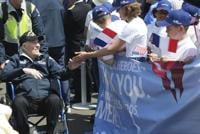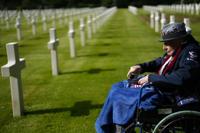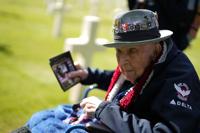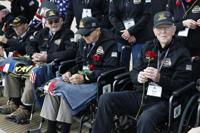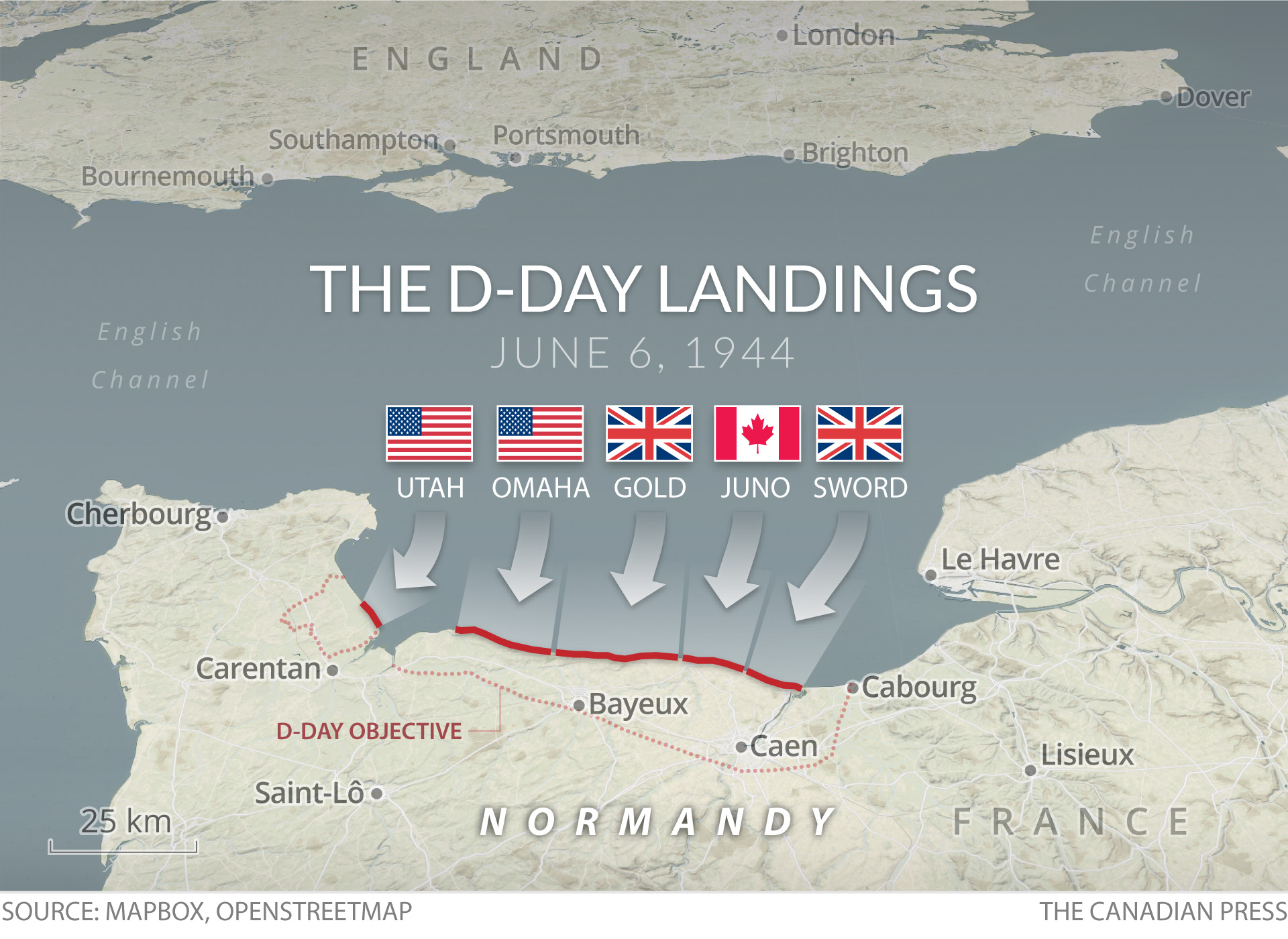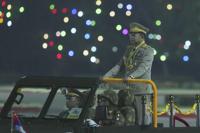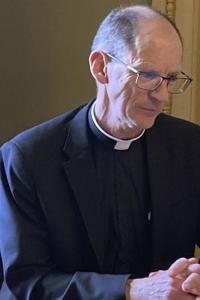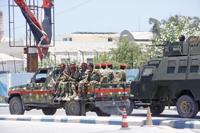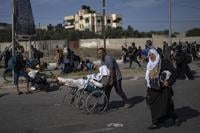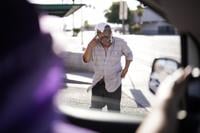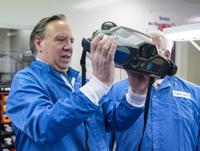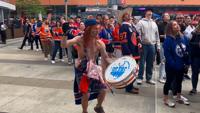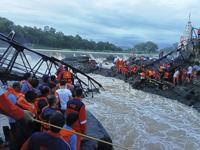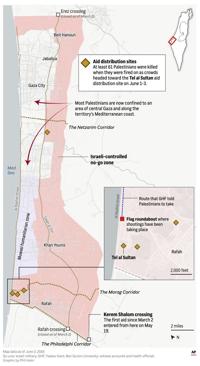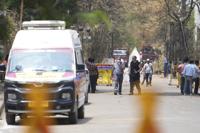BENOUVILLE, France (AP) — World War II veterans from the United States, Britain and Canada are in Normandy this week to mark 80 years since the D-Day landings that helped lead to Hitler’s defeat. The Associated Press is speaking to veterans about their role in freeing Europe from the Nazis, and their messages for younger generations.
RICHARD “DICK” RUNG
D-Day veteran Dick Rung was 19 when he was assigned to a tank landing craft that landed on Omaha Beach on June 6, 1944. Now 99, the memory is still alive as he recounts time spent hosing down the deck of the blood of those killed.
“Two of the soldiers that got hit — badly hit — we couldn’t save them but we covered them with blankets and the blankets soaked up their blood. Finally, the skipper said ‘we can’t leave it like this’ so we got out the fire hose and we washed down the deck and the blood sort of disappeared,” he recalled Wednesday.
“I was only a kid and most of the crew was too. I wasn’t trained for this,” he said. Rung’s craft stayed in Normandy for almost 5 months transporting troops, supplies and vehicles from larger ships to shore. He then headed to the Pacific Theater where he spent the rest of World War II. Describing the brutality of war, Rung concluded: “I’m a peacemaker, I’m not going to do this again.”
ANDY NEGRA
Andy Negra, 100, was born in Pennsylvania and was the first in his family to graduate from high school. He joined the U.S. Army in 1943 and landed on Utah Beach in Normandy on July 18, 1944, with his unit. At that point, he said, German forces were still only 20 miles (32 kilometers) away from the beach.
“You didn’t think of dying. ... You knew what you had to do. And when the time comes, you did it. That’s the way I looked at it,” he said.
“What could you be scared of if you don’t know what you’re going to be scared of? That was my philosophy. ... So I was never scared. I had close calls, there was a lot of action. But until you entered into that action. Why be scared?”
Negra this week visited the Normandy American Cemetery of Colleville-sur-Mer and attended a series of D-Day celebrations with a group of about 50 U.S. veterans. The 80th anniversary “is the same as when I went through the towns during WWII,” he said. People “were in the windows, in the doorways and they were on the streets. The difference is there were not as many people then as there are now.”
Negra said he is still deeply moved by the warm French welcome in Normandy. “The celebration started when we liberated each town because they clapped and they’ve been clapping and saying nice things all the way from World War II, all the way until now,” he said.
MARIE SCOTT
On D-day, Marie Scott experienced British forces landing on the Normandy coast through her earphones. As a 17-year-old radio operator in the Women’s Royal Naval Service, she relayed messages to the Normandy beaches and waited for the recipient to open his channel and reply.
“I heard everything,” Scott, who will soon turn 98, said. “I could hear all the background noise, the machine gun fire, the bombs dropping, aircrafts, men shouting orders, men screaming. It was horrendous.”
“But I had the job to do,” she explained. “I had no time to be alarmed.”
“When you heard that amount of firepower, you knew there had to be casualties … It was an enormous price to pay. But the price we had to pay,” she said.
Scott was awarded the Legion d’Honneur, France’s highest order of merit, for her role on D-Day, in 2019.
“Women are very important even in war. They may not be part of the fighting element, but we were very, very small cogs in an enormous wheel. And without those cogs, the wheel doesn’t work,” she said.
On Tuesday, Scott attended a ceremony at Pegasus Bridge, one of the first sites liberated by Allied forces from Nazi Germany. She said it was important for her to be back for the commemorations, because “it evokes memories of a very special day for me, when I first realized the true horror of war, I suppose. I think, probably, I grew up on that day, so it’s important to come back. Very emotional but important.”
FRED TAYLOR
Standing this week on what, on D-Day, were the blood-soaked sands of Omaha Beach, World War II fighter pilot Fredric Taylor found himself thinking of a high school friend who was killed in a disastrous rehearsal for the June 6, 1944, Allied landings in Normandy, France, that helped change the war’s course.
Taylor, clutching a single white daisy in his hands and staring out across the English Channel, which the Allied air, sea and land armada crossed on D-Day, said his classmate was killed in Operation Tiger. Those training exercises for the Normandy invasion were held on the southern coast of England from December 1943 to April 1944.
On April 28, 1944, German torpedo boats attacked U.S. landing ships taking part in the drills. The website of says the attack left 198 Navy sailors and 551 Army soldiers dead or missing.
The now 102-year-old Taylor was a P-51 Mustang fighter-pilot in WWII, shipping out to Italy in 1945 in the war’s final months. Nazi Germany surrendered in May.
His visit to Omaha, as part of a WWII veterans group flown to Normandy by American Airlines for the 80th anniversary of D-Day, was the first time Taylor had set foot on Omaha Beach, the most heavily defended and deadliest of the five Allied landing areas.
“The first waves had it the worst, I think, and so many died. They were sitting ducks right here for the Germans,” Taylor said. “I was pretty lucky. I was flying the P-51 fighter plane in Italy, so I was not here, but some of my friends were.”
A “high school classmate of mine died in the preparation, Operation Tiger, and the rehearsal for D-Day,” he added. “It means a lot to me to be here.”
PAPA JAKE
“Thank you, guys. Thank you.” Sitting in a wheelchair in front of the graves of fallen comrades at the Normandy American Cemetery, D-Day veteran Jake Larson wanted to let them know out loud that they are the real heroes for giving their lives for the liberation of France and Europe from Nazi Germany — not him.
The 101-year-old American, best known on social media under the name “Papa Jake,” with more than 800,000 followers on TikTok, Larson said “I’m a ‘here-to.’
“People say what is a ‘here-to’? I say I’m here to tell you I’m not a hero. It’s those guys up there that gave their life so that I could make it through. That’s what a ‘here-to’ is.”
“How is it possible that I went through five battles, plus landing on Omaha Beach without getting a scratch?'' he asked. ‘’Say there is a God. God just protected me.”
Born in Owatonna, Minnesota, Larson enlisted in the ��ɫtv Guard in 1938, lying about his age as he was only 15.
In 1941, his guard unit was transferred into federal service and he officially joined the Army. In January 1942, he was sent overseas and was stationed in Northern Ireland. He then became the operations sergeant and assembled the planning books for Operation Overlord.
He landed on Omaha Beach in 1944, where he ran under machine-gun fire and made it to the cliffs without being wounded.
“I’m lucky to be alive, more than lucky,’’ said Larson, who now lives in Lafayette, California.
FLOYD BLAIR
Floyd Blair, 103, served as a fighter pilot in the Army Air Corps. On June 6, 1944, he flew in two support missions across Omaha Beach as the Allied invasion began.
“I saw one of the saddest things I’ve ever seen. The color of the water changed,” he recalled Tuesday as he was paying tribute to fallen comrades at the American cemetery of Colleville-sur-Mer.
“Those poor guys on the ground deserve all the credit they can get. The paratroopers, the armored forces, the ground troops. They are the ones,” he said.
After D-Day, Blair participated in missions to support and protect Allied troops. His targets included German tanks, troop trains and other threats to the advancing troops and his radio was tied directly into the U.S. tanks on the ground.
BOB GIBSON
“I’m living on borrowed time now,” Bob Gibson, 100, said enthusiastically as he arrived at the Deauville airport in Normandy. “I want to see the beach again.”
Gibson was drafted into the Army in 1943 and was sent to Britain. On June 6, 1944, he and his unit landed on Utah Beach in the second wave.
“Terrible. Some of the young fellows never ever made it to the beach. It was so bad that we had to run over (them) to get on the beach. That’s how bad it was,” he said.
Gibson drove an M4 tractor with guns, engaging the enemy day and night. He continued to serve through Normandy and headed to Germany.
“You wake up at night every once in a while too. It seems somebody’s shooting at you. But we were glad to do it. That was our job, we had to do it, right?’’
Gibson, of Hampton, New Jersey, pondered the time that’s passed since then, and said this will probably be his last D-Day anniversary in Normandy.
LES UNDERWOOD
Les Underwood, 98, a Royal Navy gunner on a merchant ship that was delivering ammunition to the beaches, kept firing to protect the vessel even as he saw soldiers drown under the weight of their equipment after leaving their landing craft.
“I’ve cried many a time … sat on my own,’’ Underwood said as he visited Southwick House, on the south coast of England, the Allied headquarters in the lead-up to the Battle of Normandy. The event Monday, sponsored by Britain’s defense ministry, came before many of the veterans travel to France for international ceremonies commemorating D-Day.
“I used to get flashbacks. And in those days, there was no treatment. They just said, “Your service days are over. We don’t need you no more.’’’
BERNARD MORGAN
About 20 British veterans gathered on the deck of the Mont St. Michel ferry bound from England for northern France, as crowds gathered on the deck and along the shoreline to wave and cheer for them on their voyage to D-Day commemorations.
“It was more pleasant coming today than it was 80 years ago,’’ chuckled Royal Air Force veteran Bernard Morgan, who worked in communications on D-Day.
___
Kirka reported from Portsmouth, England, and aboard the Mont St. Michel. Associated Press writer John Leicester on Omaha Beach contributed to this report.


